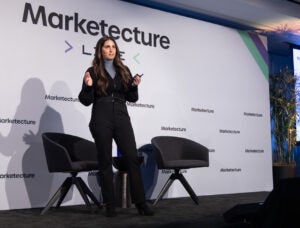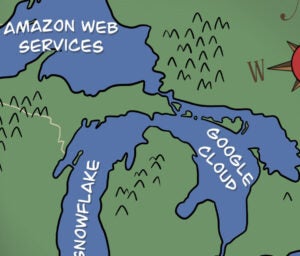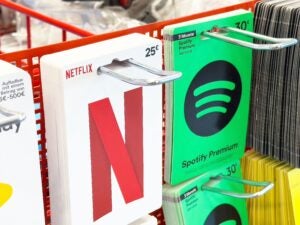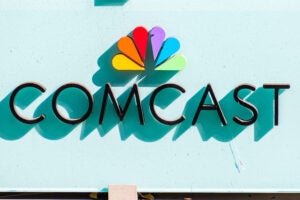 If MediaMath co-President Mike Lamb has his druthers, the convergence of ad tech and marketing tech – the industry’s current inescapable narrative – will manifest in two ways.
If MediaMath co-President Mike Lamb has his druthers, the convergence of ad tech and marketing tech – the industry’s current inescapable narrative – will manifest in two ways.
The first is beginning to happen: a set of integrations that advertisers or their agencies can use to clip together their paid media platform to their marketing tech platform.
The second manifestation is way cooler: a button built into a marketing tech system that, toward the end of the campaign workflow, enables the seamless purchase of media based on budget and marketing goals.
But while that type of deep integration is technically possible, it’s not happening quite yet for a number of reasons – many cultural, some technological and some around data governance. After all, connecting the anonymous data sets in ad tech with information about known customers can be a delicate dance.
The culture clash between ad tech and marketing tech, which a few years ago seemed to be the main inhibitor, is starting to dissipate for reasons that have already been discussed. To recap: Marketer needs drive this merging because they want to understand the entire customer journey, and ad tech vendors are aware that they need to change the way they communicate their value to marketing tech providers. At the same time, technologies like DMPs enable data sharing across different tech systems and communication channels.
Dan Salmon, managing director at BMO Capital Markets, pinpointed Oracle’s acquisition of BlueKai in 2014 as the real catalyst. To be clear, BlueKai’s acquisition wasn’t an industrywide ah-ha moment for ad tech. Many vendors, like Turn, were predicting the confluence well before Oracle made its move. (Turn has partnerships with Adobe, Marketo, IBM ExperienceOne, SAP Hybris, Salesforce.com, Kenshoo, Maxymiser, Monetate and Optimizely.)
However, the acquisition indicated the acceptance of ad tech from a sister industry that had previously been resistant.
“That was a major enterprise software company making inroads with advertising tools,” Salmon said.
MediaMath’s Lamb also looked at this moment as a watershed: “Oracle, whether they knew it or not, was getting into ad tech businesses with BlueKai and Datalogix. They both just happened to look like data businesses.”
Oracle, for its part, acknowledges that the BlueKai acquisition was a major push into the ad tech ecosystem, though its head of product marketing, Chris Lynch, said the company is still “early in the process” and just beginning to see converged ad tech/marketing tech use cases develop. The Datalogix buy, he added, pushed Oracle further down that path by providing the capabilities to connect online media buying and marketing activity to offline buying.
And there’s been a lot of partnership activity since BlueKai went off the market. Marketo has hooked up with LinkedIn, Rocket Fuel, Turn and MediaMath. MediaMath just announced a slew of API connections with marketing platforms like Oracle’s Eloqua and IBM’s Digital Analytics, Interact, SilverPop and Tealeaf applications.
Meanwhile, Oracle rival Adobe, which nurtures its own ad tech partnerships, in March debuted its search-centric Media Optimizer application as a bona fide demand-side platform.
It’s possible that all this partner activity stems from independent ad tech vendors setting themselves up for acquisitions, especially as the industry has lost investors’ favor. Elgin Thompson, managing director at Digital Capital Advisors, noted that Oracle partnered with Datalogix right before purchasing.
“Ad tech pipes have to integrate with other pipes, or the system breaks,” he said. “It makes more sense than not that your acquisition partner will generate from an existing business relationship.”
Or these partnerships might simply signal tech vendors trying to add value to their products. Building a stronger business certainly makes one a more attractive acquisition target – but it’s also necessary to thrive independently in a hypercompetitive industry.
Whatever the reason behind this dating activity, there are still a few issues that could send the stakeholders into couples therapy. Gartner research director Martin Kihn noted in a column that ad tech and marketing tech players traditionally haven’t understood the value of each others’ solutions. That’s clearly changing. But Lamb pointed to another disconnect: Marketing tech favors licensed-based business models while ad tech tends toward spend-based models.
Despite Gartner’s prediction that by 2017 CMOs will have bigger tech budgets than CIOs, marketers still think in terms of media budgets.
“[CMOs and agencies] have an established history of paying for the technology that enables that media spend out of the media budget,” Lamb said. He anticipates marketing tech vendors will also accommodate the business models that the ad tech vendors favor.
If marketing tech vendors want to go beyond the CIO or CTO, they’ll need to serve the bulk of the CMO’s budget, which is often paid media. And if the ad tech levers in a marketing cloud are pulled by the media agency, the percent-of-spend model is definitely going to apply.
Even with these consolidated systems, Oracle’s Lynch noted that marketing tech is still generally controlled by digital marketers, while the ad tech still tends to fall under the purview of the head of advertising or media agency.
Of course, even this configuration is changing. “We’re starting to see heads of digital technology,” he said. “Groups that are a liaison between the marketing and IT organization. It’s a complex project because there are three core stakeholders, and you’re bringing in data from all over the enterprise.”
Marketo CMO Sanjay Dholakia said these combined systems are mostly a brand play. “It’s the brands who see this immediate value and promise,” he said. “It doesn’t live with the agencies, which are just execution arms. All of the customer data sits with the brands.” Of note: Marketo sells directly to brands.
So does all of this movement indicate a major shift in the way marketing is executed?
Sheldon Monteiro, CTO at Publicis Groupe digital agency SapientNitro, is skeptical. For one, he’s not certain whether the narrative around the ad tech/marketing tech conflation is born of reality or hype.
He’s also not certain when these integrations will pay dividends.
“Do I believe we’ll see a lot richer contextual experiences 12 or 18 months from now? We’ll see incremental improvements,” he said.
It’s admittedly hard to find proof points.
As Lynch pointed out, there aren’t yet a lot of converged ad tech/marketing tech use cases, and certainly not many public ones. Vendors will quietly mention a few cool deployments or allude to impressive business results, but getting clients to talk is notoriously difficult. Turn has a posted case study about collaborating with Marketo for 3 Day Blinds and has spoken about its hooks into Kraft’s proprietary marketing stack.
But in general, it’s still a mystery how well these integrations actually work. Vendors might say they’ve developed APIs that latch onto different platforms, but these connections have varying qualities. Does data flow both ways? How quickly does it flow? What sort of data is made available to each system?
“There’s varying degrees of sophistication in terms of what you want to do,” said Matt Westover, Turn’s product marketing lead. “Sending in pre-built segmentation at a user level and automating it, via a real-time event stream, is relatively simple.”
A more complicated connection might be something that affects bidding strategy. Say a car insurance company, which already runs lookalike targeting through the platform, wants to add an extra factor. The company knows that customers in Illinois are statistically more profitable than customers from Florida. “It’s not that they want to target just Illinois, but they’ll have a slightly higher bid based on that narrow geoset,” Westover said.
Few clients, however, are doing anything that complex. “These are really early days in this,” Westover explained. “The bulk of people, I’d say 95%, are still getting a lot of mileage from the simple segmentation.”
But SapientNitro’s Monteiro indicates the ad tech-marketing tech connections are still on training wheels.
“There will be a break when we really see that contextual targeting and relevance happening in real time,” Monteiro said. “And the quality of the data in these ad networks has to get a lot more current.”
While it’s natural that ad network data doesn’t have the same impact as the first-party assets powering marketing tech, it certainly has its value. “The ad tech partners have data on where else a person has been during their travels on the web,” said Dholakia. “Marketo won’t be aware of websites you visited that aren’t in the Marketo system.”
But though ad network data can clear up some of the foggy patches along the path to purchase, that’s not always good enough for advertisers. Agencies like SapientNitro want to understand each dataset’s cleanliness and precision (whether segment-level data includes pools of thousands, hundreds or even tens of individuals).
Another complication: The marketing platforms that ad tech vendors try to integrate with are often products of acquisition and, despite the messaging around them, are not native to whatever stack they are housed under.
The APIs and direct connections developed by various ad tech companies are on an application-by-application basis. Turn develops pre-built connections based on customer requests. To date, this is largely relegated to email marketing platforms (though strangely it hasn’t seen as much demand for connections to Oracle’s Responsys or Salesforce’s ExactTarget) and, increasingly, ecommerce platforms.
Westover said there isn’t yet a standard like OpenRTB to connect ad platforms to marketing platforms, though he expects one in the coming years. Unfortunately, if a marketing platform is built on a foundation of creaky old code and a direct connection isn’t possible, data will have to route through a database, an intermediary connecting the two systems. This introduces latency, and kills off the ability to perform real-time functions like buying an impression at auction.
And while Westover said most marketing platforms are up to date and can be connected to other systems, often within weeks, SapientNitro from its digital agency perch sees “a wide array of legacy and bespoke CRM systems.”
Finally, data-quality and transference issues aside, privacy compliance remains a big hurdle. While vendors give lip service to the topic, it’s the brands and agencies that pay the piper if an issue comes up, Monteiro said, since privacy breaches erode brand value.
Erin Winters, VP of marketing strategy at Acxiom, agreed that responsibility lies first with the marketers. “It starts with the brands,” she said. “Then the brands need to look to the marketing tech companies who can manage that.”
Acxiom, which owns data onboarder LiveRamp and maintains partnerships with marketing tech companies and media agencies, released a study last week claiming that brands don’t often understand the extent to which consumers are comfortable getting messages from them.
“You’re taking different data sets, combining them, and that can make something that’s non-sensitive and anonymous into known data tied to an individual,” Winters said.
Monteiro also worries less about the lack of precedent.
“How precise can you get when you haven’t permissioned a brand to target you in a very specific way?” he wondered. These issues haven’t played out on either the legal courts or those of public opinion. Until they do, it’ll be difficult to get full brand buy-in on a converged marketing and ad tech solution.














